HOME » Research Thematics
Research Thematics
Ecology

At Bossou more than 200 plant species, representing approximately 30% of
available species in the habitat, are consumed by the chimpanzees, comprising more than 246 plant parts (Sugiyama and Koman 1992). Yamakoshi (1998) showed that Bossou chimpanzees spend
approximately 60.7% of their feeding time consuming fruit. Leaves and woody pith are the next two most important foods for the chimpanzees at this site. Indeed, Bossou chimpanzees spend
about 10.8% and 10.1% respectively feeding on these two food items. Seeds and the pith of herbaceous plants also comprise a non-negligible portion of their diet. Takemoto (2002) also
noted that cultivars comprise 6.4% of the annual diet of Bossou chimpanzees and are thus fully integrated in their dietary repertoire, although their seasonal proportion in the diet can
fluctuate quite significantly (Yamakoshi, 1998). Bossou chimpanzees also eat flowers, bark, roots and tubers, tree gum and insects; e.g. adult termites (Isoptera) and ants (Dorylus
spp. and Oecophylla longinoda) and the eggs and larvae of ants, bees and several species of beetle such as the Raphia coleopteran (Rhynchophorus quadrangulus). Other food
items consumed more infrequently include algae, mushrooms, honey, bird eggs and mammals such as the tree pangolin (Phataginus tricuspis). Hunting for animal prey at this site is
relatively rare compared to other sites where chimpanzees have been studied, probably due to the paucity of other mammalian species in the habitat.
Yamakoshi (1998) showed that, when fruits are scarce, Bossou chimpanzees effectively increase their tool-use activities, especially nut-cracking and pestle pounding, in order to gain
access to otherwise inaccessible food resources and to boost their energy intake. In addition, during such times of fruit scarcity, when food resources may be patchily distributed and
more rare, Takemoto (2000) demonstrated that Bossou chimpanzees spend less time feeding and moving and decrease their dietary diversity.
Demography and Social Organization
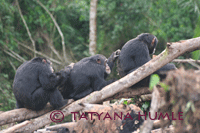
Factors affecting party size and composition at Bossou have been investigated. Sakura
(1991, 1994) founded that the pattern of party formation of the Bossou chimpanzees is very similar to that observed in other populations where influential factors influencing party size
and composition include food supply, presence of danger or predators, estrous females and infants.
However, Bossou chimpanzees differ from other communities in that they tend to form more cohesive groups (Sugiyama and Koman, 1979a) and inter-female relationships are highly affiliative
when compared with those of the Gombe and Mahale communities in Tanzania (Sugiyama, 1988). Furthermore, male-male grooming frequency was found to be lower than that recorded in the east
African subspecies (P. t. schweinfurthii). The community size at Bossou is not large and since 1976 the number of adult males has been small. The Bossou community has atypical
demographic features and population dynamics, which can possibly be explained by its semi-isolation from adjacent communities in the Nimba Mountains and its access to high energy foods
such as crops and oil-palms during periods of fruit scarcity.
Tool-use, cognition and development

The Bossou chimpanzees display a large repertoire of tool-using behaviors,
some of which are unique to this community. Chimpanzees at Bossou are well known for using a stone hammer and anvil to crack open oil palm (Elaeis guineensis) nuts (Sugiyama
and Koman, 1979b). They have also been observed using leaves for drinking water, sticks or stalks of vegetation to consume insects, honey or algae, and petioles of the oil-palm tree
as pestles to extract the heart of the palm trunk.
Among all the tool-use behaviors observed in the wild, nut-cracking is, probably the most sophisticated performed by chimpanzees in the wild (Matsuzawa, 1994). In 1989, Sugiyama set
up with the assistance of T. Fushimi an outdoor field laboratory known as the "bureau" at the top of a hill in the core range of the chimpanzees. Matsuzawa and colleagues then started
field experiments at the "bureau" to gain more insight into nut-cracking behavior, by providing the chimpanzees with stones and nuts (Sakura and Matsuzawa, 1991; Matsuzawa, 1991,
1994; Fushimi et al., 1991; Sugiyama et al., 1993b; Biro et al., 2003). These longitudinal experimental field studies revealed the ontogenetic development of stone tool-use and
suggested the existence of a critical learning period for acquisition, spanning the ages of 3 to 5 years old. (Inoue-Nakamura and Matsuzawa, 1997).
Studies of tool-use have also focused on ant-dipping among Bossou chimpanzees (Humle and Matsuzawa, 2002; Yamakoshi and Myowa-Yamakoshi, 2004). Observations suggest a strong influence
of prey (Dorylus spp.) characteristics, including aggressiveness and/or gregariousness, on tool length and technique employed by the chimpanzees.
Communication and social interactions

Chimpanzees possess a broad and flexible repertoire of vocalizations (Goodall, 1986), composed by several variations of grunts, barks, screams and hoots (Mitani, 1996), and which have as main function to express emotions (Goodall, 1986). These vocalizations can be directed to members of the community, members of neighbor communities or external stimuli, as food or animals of other species (Goodall, 1986). Although previous studies have demonstrated significant "regional" variations in some vocalizations (Arcadi, 1996, Mitani, Hasegawa, Gros-Louis, Marler & Byrne, 1992, Mitani, Hunley & Murdoch, 1999), a relatively small amount of data have been collected and compared among different populations of wild chimpanzees. For that reason, the vocal behavior of each particular community of chimpanzees needs to be studied in details and be considered as unique in some aspects. Short-distance and long-distance calls have been recorded by Sousa (in prep.) in order to describe/determine the vocal repertoire of Bossou chimpanzees and to understand how emotional state, individual relationships, social context and age affect this acoustic signals. The vocal recordings have been done using continuous recording method. Whenever possible, the context within which the vocalization occurred, the identity of the vocalizer and to whom it was directed were registered. Two different methodologies have been used across the four one-month periods of recording (2002 to 2006): 1) Recording of the vocal behavior of the chimpanzees simultaneously with the video recording of the tool-using sessions at the Bureau. 2) Recording of the vocal behavior mainly by following a different focal animal every day. Although each day a different focal individual/pair was followed, all vocalizations emitted by other individuals in the vicinity were also recorded. At the Bureau, the identification was done by direct observation by Sousa, and when following the chimpanzees in the forest, it was done with the help of the guides, who were able to identify the individual by the vocalization. By another, the clear acoustic distinctiveness existing among individuals of a same group (Marler and Hobbett, 1975, Mitani et al., 1996) will be studied and compared with the results obtain through computer-mediated tasks in captive chimpanzees (Martinez et al., in prep.).
Chimpanzees' culture
Chimpanzee culture
Extensive surveys of communities adjacent to Bossou have shown that population- specific
details of tool use, such as the selection of species of nuts as targets for cracking, cannot be explained purely on the basis of ecological differences. Oil palm (Elaeis
guineensis) use for feeding purposes was investigated across the three chimpanzee communities - Bossou and Séringbara in Guinea and Yealé in Côte d'Ivoire (Humle
and Matsuzawa, 2004). When comparing the three sites, Bossou chimpanzees demonstrated the greatest frequency of use of the oil palm, while Séringbara chimpanzees failed so far to
exhibit any uses and Yealé chimpanzees showed all uses observed at Bossou excepting pestle pounding and mature leaf pith-feeding. We found no clear difference in proximate
environmental variables underlying observed variations in use between the three sites, yielding the conclusion that these differences are cultural. Assuming individual interchange
between these communities and the involvement of social learning in the intra-community transmission and maintenance of these uses, this result raises interesting questions about
diffusion of behavior between neighboring chimpanzee communities.
Matsuzawa and colleagues have been carrying out field experiments on social transmission of behavior as an indirect approach to illuminate key aspects of both cultural innovation and
transmission between neighboring communities of chimpanzees (Matsuzawa, 1994, 1996; Matsuzawa et al., 2001; Biro et al., 2003). In the outdoor nut-cracking laboratory, nuts of
Coula edulis and Panda oleosa, normally unavailable in the Bossou range, were provided and the reaction of the chimpanzees observed. Responses of individuals toward the
novel items differ markedly with age, with juveniles being the most likely to explore. Furthermore, subjects are highly specific in their selection of conspecifics as models for
observation, attending to the nut-cracking activities of individuals in the same age group or older, but not younger than themselves. Together with the phenomenon of intercommunity
migration, these results demonstrate a mechanism for the emergence of culture in wild chimpanzees.
Crop-raiding in the Bossou chimpanzees

Crop-raiding by wildlife is one of a range of adaptations to a loss of natural
habitat allowing greater access to an array of energy-rich food. Many non-human primate species have adapted their feeding repertoire to include crop-raiding as part of their
ecological strategy.
Chimpanzees bordering agricultural land and human settlements frequently raid crops and can compete with humans over natural resources. Availability of and fluctuations in wild forest
foods may affect crop-raiding levels, as particular crops might be crucial for chimpanzee subsistence, while others are exploited because they are more palatable or nutritious than
wild foods.
The small home range (15 sq. km ) of the Pan troglodytes verus community at Bossou is fragmented and surrounded by cultivated orchards, fields and farms. During a 12-month
study (2004-2005), all-occurrences of crop-raiding events for simple-sugar fruits (papaya, banana, orange, mandarin and pineapple combined) were noted. Transects through the
chimpanzees' core area were monitored to asses forest fruit availability. The seasonality of cultivars was rated using questionnaires on availability in respondents' farms.
Results show that chimpanzee crop-raiding increased when wild fruits were scarce; cultivars act as fallback foods during periods of low forest fruit availability. Adult males raided
cultivars more often than other age/sex classes, suggesting greater confidence, and crop-raiding by adult male-only parties was additionally associated with increased exposure and
risk.
Effective management strategies to conserve the Bossou chimpanzees require an in-depth understanding of their ecology; findings can be extended to other great ape populations living
in restricted home ranges to mitigate risks of human-ape conflict.
(Hockings, Anderson and Matsuzawa, 2006, in preparation).
Bacteriological studies and health monitoring
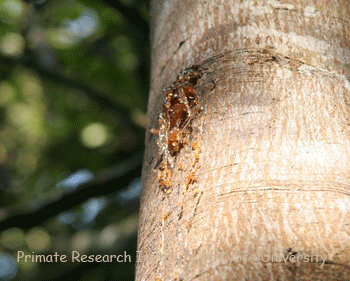
Little information is available on the intestinal bacteria of chimpanzees in
the wild due to the technical difficulties of studying intestinal bacteria in the field. In this study, molecular-based bacterial analysis was performed to overcome this difficulty
because PCR-based methods such as temperature gradient gel electrophoresis (TGGE) and amplified ribosomal DNA restriction analyses (ARDRA) of the bacterial 16S rRNA gene can be applied
to ethanol-fixed fecal samples. The common presence of bacteria belonging to the Clostridium rRNA sub-group XIVa, such as Ruminococcus obeum and Eubacterium sp., was
indicated for Bossou wild chimpanzees by ARDRA. TGGE on partial 16S rDNA followed by hierarchical clustering analysis showed a systematic difference in composition of intestinal
microbiota between wild chimpanzees and those in captivity. However, several TGGE bands commonly shared by wild and captured chimpanzees were excised, and their sequences were obtained.
They were suggested to be the Clostridium leptum subgroup bacteria, Lactobacillus gasseri-like bacterium, and Bifidobacterium pseudocatenulatum- or B.
catenulatum-like bacterium. These may be considered as common intestinal bacteria for chimpanzees and are possibly transmitted vertically over generations.(from abstract Uenishi et
al. 2006. Am. J. Primatol. in press)
The selective ingestion of plant gum exudates by chimpanzees has been frequently observed at various study sites. At Bossou, Guinea, chimpanzees also frequently ingest Albizia
zygia gum exudate. A functional explanation for this behavior is lacking, so we evaluated its possible contribution of energy in the form of short-chain fatty acids (SCFA) as well
as minerals. An in vitro fermentation study of A. zygia gum using the fecal bacteria of a Bossou chimpanzee showed that carboxylic acids were produced with a 6-hr lag phase up to
44 mmol/l by 18 hr of incubation. Acetate was the most abundant acid produced, followed by lactate and propionate. The energy supplied from the fermentation of a piece of gum exudate
(20-30 g) was negligible in comparison with the estimated daily energy requirements of chimpanzees in the wild. However, A. zygia gum exudate (20-30 g) can supply sufficient
amounts of calcium, manganese, magnesium, and potassium to fulfill the daily requirements for these minerals in chimpanzees. (from abstract: Ushida et al, Am. J. Primatol. 68:143-151,
2006).
Population genetics

The chimpanzee populations of the Bossou and Nimba regions in West Africa were genetically surveyed to 1) reveal the genetic relationship between the Bossou and Nimba populations, and 2) elucidate the evolutionary relationship between the Bossou-Nimba and other West African populations. The chimpanzee group at Bossou is characterized by its small population size, no evidence of contact with neighboring populations, and no female immigration. It is believed that most females and adolescent males emigrate from this population. To reveal the genetic signature of these characteristics, we examined the genetic diversity of Bossou and two neighboring populations (Seringbara and Yeale) in the Nimba Mountains by sequencing approximately 605 bp of the mitochondrial DNA (mtDNA) control region. A total of 20 distinct mtDNA variants were observed from 56 sequences of noninvasively collected, anonymous samples. Nucleotide diversity in the Nimba Mountain populations was 0.03-0.04, and did not differ significantly from that in the Bossou population. Very few mitochondrial variants are shared among the sites sampled, which suggests that there is little gene flow involving mtDNA. Nevertheless, no clear population structures were revealed in either population. A comparison with published sequences from West African chimpanzees (Pan troglodytes verus) indicates that the variants observed in the Bossou and Nimba regions are scattered throughout the subspecies, rather than clustered according to geographic region. This suggests that the Bossou-Nimba populations derived only recently from the common ancestral population of the West African chimpanzees, and did not pass through a bottleneck. (from abstract: Shimada et al., Am. J. Primatol. 64:261-275, 2004).
Surveys of wild chimpanzees in Nimba and neighboring sites: ecology, tool-use and conservation
Surveys in the Western part of the Nimba Mountains Biosphere Reserve
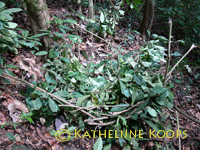
Sugiyama visited Séringbara several times since 1976. He interviewed the villagers, and
conducted two surveys of the forest surrounding the village in order to determine the presence of chimpanzees in the area. He concluded that the chimpanzees were only seasonally
transient to the region (Sugiyama, 1981). However, over 70 nests and numerous feeding remains of chimpanzees were discovered in 1999 in the forest beside the village, while
vocalizations of chimpanzees were regularly heard (Shimada, 2000).
This was further confirmed during Matsuzawa's and colleagues' visit to the Séringbara forest in January and February 2000 and Humle visits to this site between June and September
2000 and June and September 2001, during which they recorded further evidence of chimpanzees in the area, including nests, feeding remains and indications of tool use (Humle and
Matsuzawa, 2001). Many behaviors specific to the Nimba chimpanzees such ground nesting have been reported by Matsuzawa and Yamakoshi (1996). Sugiyama (1995a) was the first to report the
occurrence of ant-dipping for Dorylus ants in the Nimba Mountains. Since 2003, Humle and Koops (Koops et al, in press) have been carrying out more systematic research at this
site: their nesting surveys and progressive habituation of the chimpanzees suggest the presence of two chimpanzee communities in the Séringbara area. Further research and
consequent habituation of the chimpanzees will confirm exact numbers and group composition. Nesting patterns and characteristics of the chimpanzees in the Séringbara region of the
Nimba Mountains were investigated in depth and across seasons (Koops, 2005 ) The effects of ecological (i.e., fruit availability, habitat type) and topographical (i.e., altitude)
factors on nesting patterns were addressed. Moreover, Koops assessed whether nesting sites concur with sites of feeding activity, and whether there exists seasonal variation in nesting
patterns and characteristics. In addition, ground-nesting behavior of the Nimba chimpanzees has been specifically investigated (Koops et al, in press). Koops examined the environmental
and social factors that may account for the occurrence and distribution of ground-nesting in Nimba. The effects of season, altitude, slope and nesting tree availability on the
proportion of nests constructed on the ground were explored. The occurrence of ground nests was found not to be affected by these basic environmental factors, and social or cultural
factors may provide a more likely explanation for ground-nesting behavior in the Nimba chimpanzees.
Surveys in the Eastern part of the Nimba Mountains Biosphere Reserve
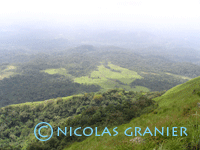
Presence of the western sub species of chimpanzee in the Nimba Mountains core area has been
reported since the late 1930s (Lamotte, 1942 and Holas, 1952). In 1941, the Nimba area has been classified as a natural reserve to protect his highly endemic biodiversity and favoured
its scientific exploration, but no specific study has focused on chimpanzees until the arrival of Sugiyama to Bossou in 1976.
Sugiyama visited the Gouela area in 1991. He saw chimpanzees, studied their nests and confirmed presence of ant-dipping (Sugiyama et al., 1995). In 1999, Shimada surveyed this area
again and further confirmed chimpanzee presence (Shimada, 2000). Nevertheless, little information is available on the chimpanzees presently populating this huge mountainous reserved
area and some places have not been surveyed at all.
In March and April 2006, Granier conducted two surveys in the Eastern part of the Nimba Mountains Biosphere Reserve, to assess the actual ecological and conservational status of wild
chimpanzee populations (Granier, preliminary report).
The first survey was carried out in the forested south foothills of the mountain range lying between Gouéla and N'Zo (sub-prefecture of N'Zo). Globally, the forest is well
preserved in this area and seems to be healthy. No villagers are cultivating inside of the Reserve's limits. Although there is a real problem of poaching, as indicated by the numerous
traps, cartridges and hunters encountered in the core area of the reserve, daily observations of many various chimpanzee tracks have permit to confirm the species' presence in this side
of the Nimba Mountains.
The second survey was carried out in the Déré forest. A very critical general situation has been observed in terms of conservation and local politics. Firstly, scares of
logging are deeply visible in this forest, which is now colonized by local people for intensive cultivation and subsistence hunting. Even if good quality patches of primary forest can
still be found, the fragmentation is so high that its consequences on ecosystems are really critical. Little scientific data is available on the Déré reserved area, and no
study has been conducted concerning specifically chimpanzees. Only one chimpanzee track consisting in a very old nest was observed in 13 days of survey.
Surveys in the Diecké forest
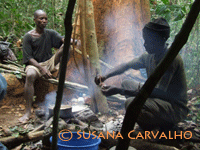
The two study sites, which we have surveyed thus far, are located beside two villages: Yossono (west of the reserve) and Nonah (east of the reserve). It still remains undetermined as to
how many chimpanzees inhabit this reserve and how many communities pervade in the area (Matsuzawa et al., 1999). But some preliminary behavioral data have emerged, especially concerning
tool-use at those sites (cf. Humle and Matsuzawa, 2001). There were recent reports of hunting of chimpanzees in the Yossono area dating back to July 2001, while hunting pressure at
Nonah does not appear to be as high. But hunting seems to be a huge problem within this reserve and may pose a considerable threat to the chimpanzee populations living in that
region.
At the moment Diecké Forest is divided in 3 levels of protection and 30 parcels, by a national project of conservation/reforestation, damage minimization and regional development
(Progerfor). The "série d`amelioration" level correspond to a peripheral area, where we can find forest fragments of slash-and-burn agriculture, for the most part to cultivate rice
fields and plant oil palm trees and secondary forest mixed with altered primary forest. Then we have "série d`utilisation durable", mostly altered primary forest and secondary
forest and finally the "série de protection integral", the core of Diecké Forest, formed mainly by closed canopy, extensive patches of rain forest, and this is the best
preserved part of the original forest (parcels 10 to 15). This heart of Diecké forest is still largely unknown.
In 2006 Carvalho continued survey in this area. KUPRI combining archaeological and primatological
methods; new zones were surveyed (achieving parcels 11 and 15) and local work teams were organized to set temporary camps in the forest. The main goal, besides searching these
chimpanzee communities, was to find new nut-cracking places and register the entire tool-use process in order to understand tool technology. KUPRI carried out 3 trips in Diecké
Forest between January and April (mainly during dry season) and set 2 temporary camps, one in Nonah area and another in Korohouan area.
In Diecké forest we found 5 new nut-cracking places (of Panda oleosa and Coula edulis). Places of Coula edulis are the first ones to be found in Diecké
forest area with this nut specie. Between trips one place had been used by the chimpanzees.
We also found fresh traces of chimpanzee's passage, feeding and sleeping, especially in Korohouan area.
Although human activities and hunting pressure are present and they continue to damage and transform the natural forest habitat as we could verify in 2006.






